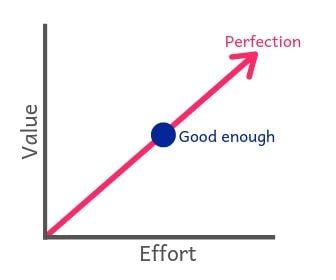How we browse the web is determined by a number of different things: what we are trying to find, how high value our search query is, the sort of person that we are.
However, for most of us, time is precious, and we will not spend hours researching every decision we need to make online.
Instead, we satisfice.
A combination of suffice and satisfy, users who satisfice will scan online content and links and find the option that looks ‘good enough’.
Satisficing is a trade off between how much value we are looking to get vs how much effort we are prepared to put in to get it.

Definition: ‘satisfice’ - Decide on and pursue a course of action that will satisfy the minimum requirements necessary to achieve a particular goal.
Satisficing has always been a common decision-making strategy. Online, we believe it is now the norm (in most situations, read on to find out about the exceptions!). In our opinion, here’s why…
- Faster internet speeds: there is less risk attached to choosing the wrong link. When it took minutes for a page to load, the associated interaction cost was high so users would pick their links carefully (i.e. they would optimise their choice) to avoid having to backtrack. These days, users are happy to flick back and forth through a site until their find what they are looking for.
- Greater online confidence: users are significantly more tech savvy these days. We are more familiar with how the online world works so know what to expect when we click on a link or interact with certain page elements.
- Design conventions: over time, digital conventions have established themselves in the web world, such as, how links are presented. Having learnt these conventions, we do not have to discover how to these various bits of functionality work and can quickly skim over areas of the page that are known to be irrelevant.
Not all users satisfice
The opposite of satisficing is optimising. Users who optimise will spend time looking for the best option, rather than settling for something that is just ‘good enough’. We see this type of behaviour more commonly in certain situations or user groups.
- When the internet is slow. As soon as internet speeds drop off, we see a return to optimising behaviour. Users do not want to take a wrong turn as it takes them so long to get back on track. Instead, they will review all the options to find the optimal solution, rather than settling for ‘good enough’.
- Blind or visually impaired users. When using a screen reader or screen magnifier, users are presented with links and headings one by one. To ensure they choose the right option they must first hear or look at all of them. They have no choice but to optimise.
- Users with low digital literacy. Users who are less confident online are more likely to take their time reviewing the content and links. Often this is due to a lack of online experience and an unfamiliarity with elements of the user interface.
How to write content for satisficers
It is well known that most users will scan content. This is especially true when satisficing, as users search the page for relevant words or phrases. There are a number of things you can do to help satisficers find the information they need. Following these principals will also make it easier for users who optimise:
- Use headings: split your content up with clear and descriptive headings so users can quickly skip to relevant sections
- Use bullet points: short lists make information stand out and easier to digest.
- Make link purpose clear: ensure all links clearly describe what they do. E.g. ‘Read more about our work’, not just ‘Read more’
- Frontload key information: Don’t bury key product facts or vital service info half way through a paragraph. Lead with key information in the first half of a sentence or page
Read more: What is UX?, Writing content for the web


